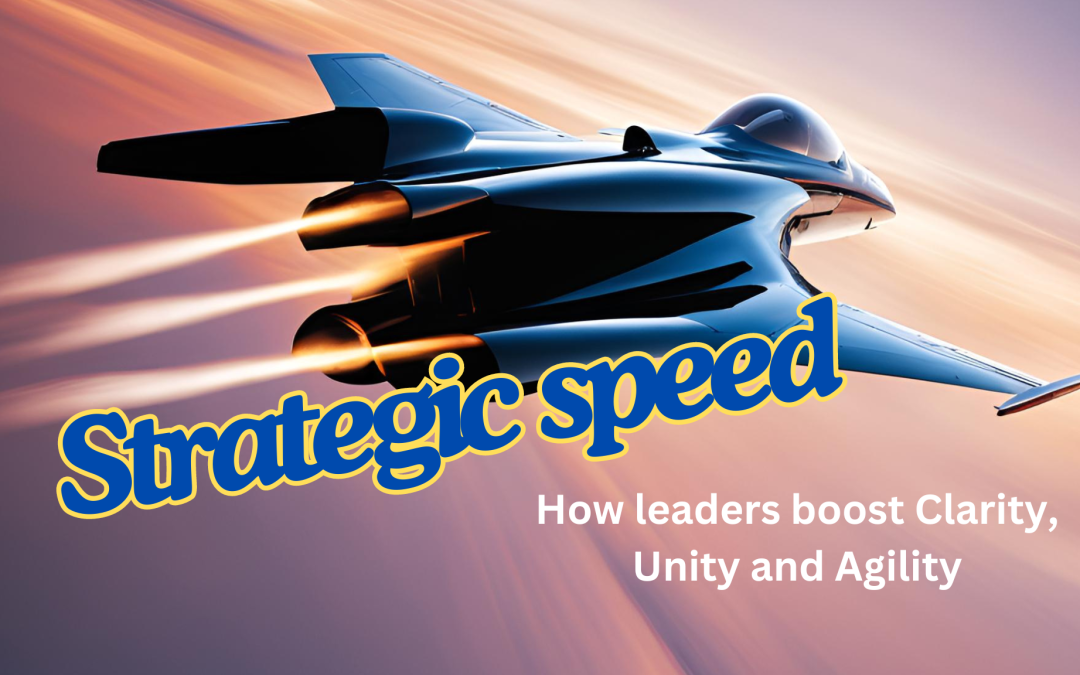The foundation of strategic speed is clarity. A well-formulated strategy should be comprehensive, clear, and supported by a strong rationale. Most importantly, it must be mutually understood across the team and the organisation.
I’ve written previously that in order to achieve strategic speed, leadership teams need to prioritise clarity, unity, and agility among themselves.
But how do you foster these elements in the team and in the wider organisation?
Based on the available literature and my own experience of working with senior teams, there are four key leadership practices that can significantly enhance these crucial elements of strategic speed.
1. Affirming Communication
The foundation of strategic speed is clarity. A well-formulated strategy should be comprehensive, clear, and supported by a strong rationale. Most importantly, it must be mutually understood across the team and the organisation.
It’s our experience that typically leadership teams invest considerable time and resources in strategy formulation but often underestimate the importance of effective communication.
Affirming communication goes beyond simply presenting the strategy; it involves explaining, contextualising, and describing the strategic journey. Leaders must articulate not only the “how” but also the “why” of getting from the current state to the desired future state. This includes discussing both the chosen direction and the alternatives that were considered and ultimately discarded.
Effective affirming communication is essential particularly to ensure everyone on the team understands and views the strategy in the same way. Any points of difference here and nuanced versions of the strategy get communicated further down the organisation, perhaps with slightly different priorities. It ensures that all team members have a complete, clear and mutual understanding of the strategy, its implications and their role in execution.
It’s this shared understanding that forms the basis for unity and aligned action throughout the organisation. It’s so important it needs time and reiteration.
2. Driving implementation
A strategy, no matter how well-conceived, is only as effective as its execution. Driving implementation is a critical leadership practice that transforms strategic intent into tangible results. This practice extends beyond mere sponsorship of strategic initiatives; it requires active and ongoing leadership engagement but has to avoid micro-management.
Key aspects of driving implementation include:
- Defining specific objectives: Clearly articulating what success looks like in concrete, measurable terms.
- Setting expectations: Establishing clear roles, responsibilities, and timelines for all involved parties.
- Empowering colleagues: Providing team members with the necessary authority, resources, and support to execute their responsibilities effectively.
- Holding people accountable: Regularly following up on progress and addressing any deviations from the plan, while avoiding micromanagement.
The challenge for leaders lies in striking the right balance between providing direction and allowing autonomy. Effective implementation driving requires leaders to maintain oversight without unintentionally stifling creativity or initiative through micro-management.
3. Managing Work Climate
A positive work climate can significantly amplify engagement, performance, and organisational speed and is something leaders have a tremendous influence in shaping and managing
Work climate refers to the overall atmosphere and environment within an organisation. Put simply it’s what it feels like to work here. It encompasses employees’ perceptions of their work environment, including factors such as communication, accountability, support, challenge and growth, recognition and reward, and trust. Work climate is something that leaders have a tremendous influence in shaping and managing.
A positive work climate can significantly amplify engagement, performance, and organisational speed. By focusing on creating a conducive work environment, leaders can foster a sense of belonging, motivation, and shared purpose among team members. This, in turn, leads to increased productivity and a more agile response to challenges and opportunities.
Leaders should regularly assess and address the various dimensions of work climate, ensuring that the organisation provides an environment where employees feel valued, supported, and empowered to contribute their best work.
4. Cultivating Shared Learning
Several studies over the years has pointed to the ability to learn from experience, share knowledge, and continuously improve as a key differentiator between high-performing “faster” organisations and their “slower” counterparts. Peter Senge of MIT Sloan School of Management has for years proposed that the only sustainable competitive advantage an organisation has is it’s ability to learn faster than its competition.
Cultivating shared learning is a critical leadership practice that enables teams to develop from experience and quickly apply lessons to emerging opportunities and challenges. (Sharing knowledge is also coincidently a component of personal leadership credibility).
This ability to learn fast for experience and apply in new and different situations is the essence of learning agility. To foster a culture of shared learning, leaders can:
- Encourage open dialogue and reflection on both failures and successes
- Implement systems for capturing and disseminating lessons learned
- Promote cross-functional collaboration and knowledge sharing
- Invest in ongoing training and development opportunities
- Recognise and reward innovative thinking and continuous improvement efforts
By prioritising shared learning, organisations can enhance their adaptability, innovation capacity, and overall agility in responding to market changes.
“The only sustainable competitive advantage is an organization’s ability to learn faster than the competition.”
Peter Senge
Implementing these four leadership practices requires commitment and consistency. Leaders should view them not as one-time initiatives but as ongoing processes that evolve with the organisation’s needs and challenges. Regular assessment and refinement of these practices can help ensure their continued effectiveness.
Moreover I’ve learned, through over 30 years of experience, that these practices need to be tailored to fit the specific context of each organisation. Factors such as company culture, industry dynamics, and team composition may influence how these practices are best implemented.
By focusing on affirming communication, driving implementation, managing work climate, and cultivating shared learning, leaders can create an environment that fosters clarity, unity, and agility and thereby accelerate the speed by which they create value and grow that value over time.
These elements are essential for achieving strategic speed and maintaining a competitive edge in the ever-moving business landscape. As organisations continue to navigate opportunities and complex challenges, these leadership practices will prove invaluable in guiding teams toward accelerated strategy execution and sustainable success.
Delivering strategic speed, reducing time to value and increasing value over time, is one of the distinguishing features of high performing senior teams. I coach senior leaders and teams to accelerate the execution of their strategy through people.
If you would like to discover if your team is operating at its optimum take our survey and contribute to our on-going research. It takes less than two minutes to complete and you will receive a personalised report.

